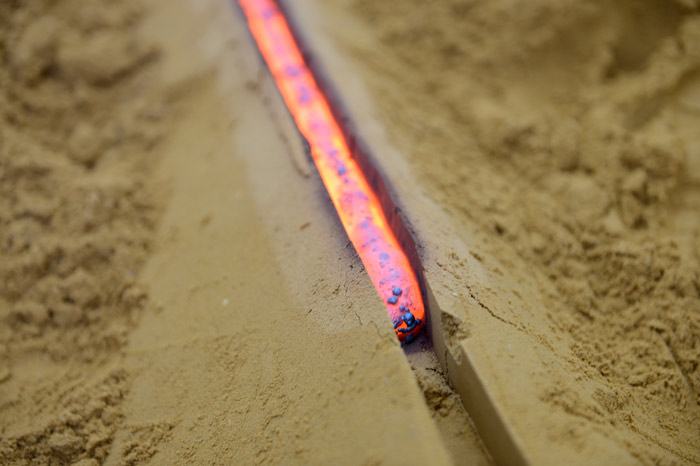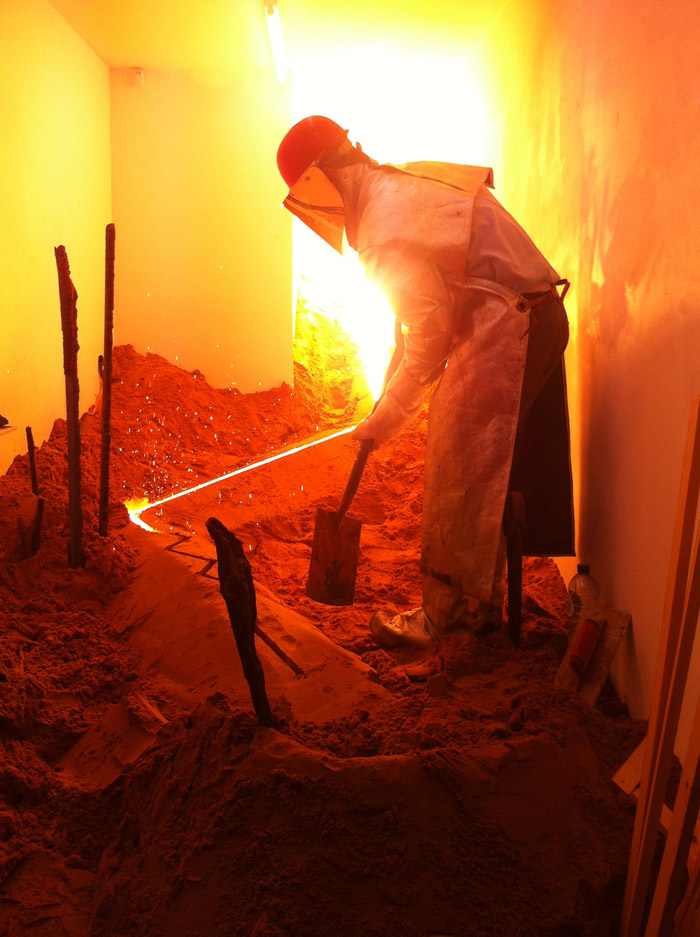Whitecross Street in east London is just a memory stick’s throw from an area that has recently been dubbed the “silicon roundabout” for playing host to a growing coterie of tech companies. However one fine, late-summer afternoon all of that humming immaterial labor looked awfully anaemic in proximity as a crane-equipped flatbed truck unloaded 25 tons of sand onto the narrow sidewalk outside Ancient & Modern Gallery. This aspect of Raphael Hefti’s performance, Quick Fix Remix, isn’t formally announced to prospective viewers. However it’s a crucial point in the infrastructural background, a kind of knowledge cloud, that makes up the very possibility of ‘the work’; a notion which is in turn destabilized through his transparent overall presentation of the productive process.
The process in question, or the “Quick Fix” aspect of the title, involves an ingenious portable device used to produce molten iron for the on-site repair of railroad tracks. The contraption itself, used all over the world, resembles a mini-keg of beer sitting on a small stand with an inverted cone screwed on its top acting as a smokestack. As is his distinct approach to art making, Hefti discovered the technique within the scope of his far-ranging, savant-like research into the technical processes that produce many of the basic, often taken-for-granted material substrates of contemporary existence. This interest in, and desire to disrupt, could be thought of as “subliminal materialism.” The notion subtends Hefti’s output, inserting a grain of sand into the modern mental vaseline that takes for granted the involvement of such a technical process as the welding of the train tracks as we sail across them.
The “Remix” part of the performance is where things get moving, and potentially splattered in 1200 degree liquefied metal. Inside the narrow, boutique retail sized gallery, Hefti has directed an army of assistants to push and pile the tons of tawny sand into a small mountain that peaks just under the ceiling’s fluorescent strip lights. Occupying the space like an earthwork on Adderall, the absurd inner-city-mountain is not purely a form for consideration, but rather a technical apparatus that will be used in the main event.
As the crowd gathered at the opening performance, forced to stand in the street due to the gallery’s repurposing, Hefti crawled up and down the mound, using lengths of wood and trowels to impress mysterious channels into the sand in the manner of an ancient alien glyph. The channels are in fact, containment paths for the flow of viscous iron that will erupt from the thermite chamber perched at the top of the slope. Donning a silver protective suit and gold-shielded helmet not unlike the kind worn by volcanologists into an erupting crater, Hefti scaled the mountain to ignite the apparatus before making a hasty retreat to a few meter’s distance, shovel in hand. With an effervescent cascade of white sparks and rollicking stream of smoke, the apparatus shot the molten steel from its chute, boiling down the zigzagging channel. The small gallery space was blindingly illuminated in stroboscopic light. Hefti traversed alongside the descending flow, coaxing the iron through the final chicane with his shovel, where it came to congeal at a cigar-shaped end glowing orange. The assembled crowd vigorously applauded both the successful cast and their own survival as witnesses.

Raphael Hefti, Quick Fix Remix performance detail, 2013. Image courtesy of Ancient & Modern Gallery.
After a few minutes rest Hefti returned with a garden-hose to accelerate the cooling process. As he doused the now-cast iron in the sand channel, the remaining molten orange turned graphite-blue beneath a tremendous cloud of metallic scented steam. The iron still extremely hot, he grasped the long fragments with a giant pair of forceps, wrested them from the channels and placed them vertically, like great spears, in the sand near the gallery’s opened street entrance. An ad-hoc shelf made from plasterboard and crudely attached to the gallery wall was also used to display smaller pieces of casting. The space was then left as is—striking a nearly parodic counterpoise between discrete white walls and the detritus of an industrial-scale experiment.
Crucial to Hefti’s performance is to understand it in a lineage of attempts to reconcile the scale of urban gallery space to the demands of the artist’s paths of investigation. Just as Walter De Maria’s 1977 New York Earth Room, effectively ridiculed the niceties and constraints of the white cube as a format for the presentation of art, Hefti’s Quick Fix Remix draws us back to many important spatial and productive relations. At a moment when many small galleries find themselves endlessly on the road at a hyperbolically proliferating schedule of fairs, Hefti returns to the specific locale, using its modestly scaled but prime metropolitan location as a node for something really happening. In doing so, he performs an argument for presence that many had thought disappeared into an infinity of teenage Tumblr accounts. One suspects that despite the fact that nearly every viewer of the performance was overcome by the urge to record it on their smartphone, that upon reviewing the images and videos at some remove, a profound distance will be felt. This distance will be a reminder of the concealed ontic webs of the contemporary experience, a preemptive follow-back.
By Paul Kneale
























